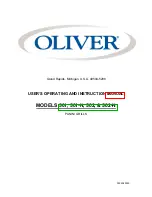
For advice on the safety and suitability of this
equipment contact your local HSS Hire Shop.
Keep children, animals and bystanders away from
the work area.
Never use this equipment if you are ill, feeling
tired, or under the influence of alcohol or drugs.
This equipment should only be used by a
competent person who has read and understood
these instructions.
Safety Goggles MUST be worn by everyone in
the work area.
Some materials contain substances which,
when inhaled, can be harmful to health. A
suitable mask must be worn when using this
equipment.
This equipment generates potentially harmful
noise levels.
To comply with health and safety at
work regulations,
ear defenders must be worn by
everyone in the vicinity.
Wear practical, protective clothing, gloves and
footwear.
Avoid loose garments and jewellery that
could catch in moving arts, tie back long hair.
Never use the equipment if highly flammable
vapours –
petrol or paint thinner fumes for example –
are present.
Always switch OFF and unplug the equipment
when not in use.
Take special care when changing drill bits – they
are sharp.
Always unplug the tool before making adjustments
to it.
Check that it is switched OFF and that you have
removed the chuck key before plugging it back in.
Having switched OFF,
always wait for the drill bit to
come to rest before putting the tool down.
Check the condition of the equipment before use.
If it shows signs of damage or excessive wear, return it to
your local HSS Hire Shop.
Make sure you know how to switch this machine OFF
before you switch it ON,
in case you get into difficulty.
Think twice before locking the ON/OFF trigger
in
the ON position using any trigger lock button fitted.
Only change the gear/speed and/or direction of rotation
when the machine is stopped.
Take special care when drilling into walls or floors,
they may contain hidden pipework, reinforcing
bars or electrical cables.
If in doubt, hire a Cable
Avoiding Tool or metal locator, to determine the exact
position of such hazards.
GENERAL SAFETY
Watch your footing.
Take special care if working other
than on firm, level ground.
Above ground-level, work
from a stable, purpose-made work platform
such as
a step-up or trestle.
Most HSS Percussion drills plug into a standard
13amp power socket. However, 110V models
(with
a round yellow plug)
must be provided with a
suitable 110V generated supply,
or powered from
the mains via a suitable 110V transformer.
If the equipment fails, or if its flex or plug gets
damaged, return it.
Never try to repair it yourself.
Keep flexes out of harm’s way,
and clear of moving parts.
Extension leads should be fully unwound and
loosely coiled, away from the equipment.
Never run
them through water, over sharp edges or where they
could trip someone.
Keep the equipment dry,
using electrical equipment in
very damp or wet conditions can be dangerous.
To reduce the risk of electric shock, use a
suitable RCD
(Residual Current-Operated Device)
available from your local HSS Hire Shop, or power the
equipment from a mains circuit with a built-in RCD.
Never carry or pull the equipment by its flex.
Ensure the equipment and power socket are
switched OFF before plugging into the
power supply.
Some models will be supplied in a carrying case and
you may find that the side handle will need to be
fitted, simply slide the handle assembly over he
drills body, then secure in place by either twisting
the handle clockwise or by tightening the wing nut.
NOTE The side handle MUST be fitted and used,
if
the bit jams during drilling the side handle will help
restrain the machine. Without the handle fitted you risk
breaking your wrist.
Fit the drill with the right bit for the job.
Open and close the chuck with the chuck
key provided.
Drill Bits
TCT drills.
General purpose masonry drill bits are
available with straight-shank or SDS fitting.
HSS (high speed steel).
Used mainly for drilling holes
in steel but also used for wood and plastics.
Flat (spade) bits.
Designed for use in timber products.
GETTING STARTED
ELECTRICAL SAFETY
If the depth stop is to be used, this may be set either by
releasing the wing nut holding it in place or by twisting
the forward handgrip to loosen/tighten the depth
rod’s guide.
The machine offers a choice of settings,
select the
correct speed for the job.
As a rule of thumb,
the
harder the material and/or the larger the hole, the
slower the drill speed.
On most models, there is a sliding speed selection switch
on the side of the tool body.
If drilling into masonry, set the drill to ‘hammer’.
Depending on which model you have, the hammer
action is turned on and off
with a sliding switch or
control knob.
If drilling into timber, metal or plastic turn the
selector to drill only.
Plug the machine into its power supply and switch
the supply ON.
To start the drill, squeeze in the ON/OFF trigger,
to
stop simply release the trigger. For safety reasons you are
advised not to use the trigger lock.
BASIC TECHNIQUES
Hammer
ON/OFF
Control Knob
Depth
Gauge
Wing Nut
Chuck
Key
Side
Handle
Wing Nut
Side
Handle
Speed
Selector
ON/OFF
Trigger
Trigger
Lock Button
Percussion Drill




















